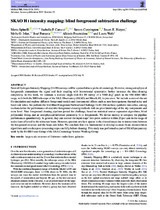| dc.contributor.author | Spinelli, Marta | |
| dc.contributor.author | Carucci, Isabella, P. | |
| dc.contributor.author | Cunnington, Steven | |
| dc.date.accessioned | 2022-03-02T13:15:37Z | |
| dc.date.available | 2022-03-02T13:15:37Z | |
| dc.date.issued | 2022 | |
| dc.identifier.citation | Spinelli, M., Carucci, I.P., Cunnington, S., Harper, S.E., Irfan, M.O., Fonseca, J., Pourtsidou, A. and Wolz, L., 2022. SKAO H i intensity mapping: blind foreground subtraction challenge. Monthly Notices of the Royal Astronomical Society, 509(2), pp.2048-2074. | en_US |
| dc.identifier.issn | 00358711 | |
| dc.identifier.uri | http://doi.org/10.1093/mnras/stab3064 | |
| dc.identifier.uri | http://hdl.handle.net/10566/7302 | |
| dc.description.abstract | Neutral Hydrogen Intensity Mapping (H I IM) surveys will be a powerful new probe of cosmology. However, strong astrophysical
foregrounds contaminate the signal and their coupling with instrumental systematics further increases the data cleaning
complexity. In this work, we simulate a realistic single-dish HI IM survey of a 5000 deg2 patch in the 950–1400 MHz
range, with both the MID telescope of the SKA Observatory (SKAO) and MeerKAT, its precursor. We include a state-of-the-art
HI simulation and explore different foreground models and instrumental effects such as non-homogeneous thermal noise and
beam side lobes. We perform the first Blind Foreground Subtraction Challenge for HI IM on these synthetic data cubes, aiming
to characterize the performance of available foreground cleaning methods with no prior knowledge of the sky components and
noise level. Nine foreground cleaning pipelines joined the challenge, based on statistical source separation algorithms, blind
polynomial fitting, and an astrophysical-informed parametric fit to foregrounds. We devise metrics to compare the pipeline
performances quantitatively. In general, they can recover the input maps’ two-point statistics within 20 per cent in the range of
scales least affected by the telescope beam. However, spurious artefacts appear in the cleaned maps due to interactions between
the foreground structure and the beam side lobes. We conclude that it is fundamental to develop accurate beam deconvolution
algorithms and test data post-processing steps carefully before cleaning. This study was performed as part of SKAO preparatory
work by the HI IM Focus Group of the SKA Cosmology Science Working Group. | en_US |
| dc.language.iso | en | en_US |
| dc.publisher | University of the Western Cape | en_US |
| dc.subject | Neutral Hydrogen Intensity Mapping | en_US |
| dc.subject | Cosmology | en_US |
| dc.subject | Galaxies | en_US |
| dc.subject | deconvolution | en_US |
| dc.subject | Blind foreground subtraction | en_US |
| dc.title | SKAO HI intensity mapping: blind foreground subtraction challenge | en_US |
| dc.type | Article | en_US |

